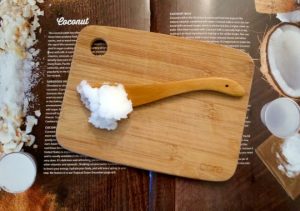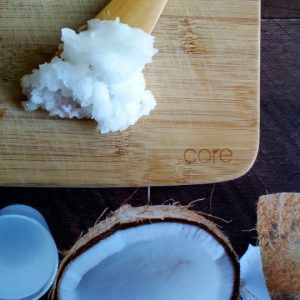
Coconut oil hit the scene like a tropical storm with people snapping it up for use in smoothies and skincare alike. But not so fast! This fruit is not the panacea for skin that many people purport it to be. In fact, it’s further proof that there are few ingredients and products that are universally beneficial—no matter what the latest fad insists.
Believe me, I love coconut oil and use it often. For baking, it easily replaces margarine in most chocolate cake recipes with delectable results. And on sweet potatoes? Nom nom! My hair drinks it in as a leave-in treatment like a dog laps up water on a summer day. Spreading it over my body after a shower, I’m transported to a getaway worthy of Organic Spa Magazine, and my torso gleams. But my face? That’s another story.
Many people erroneously believe that when they switch to more natural and organic products, their skin will automatically clear up. Unfortunately, that is not the case. Trial and error plus a bit of research never hurt before embarking on a new regimen. When I use coconut oil on my face—rather than improve my complexion—it causes me to break out in blemishes. Evidently, I’m not the only one, as I recently started noticing more and more people saying that they can’t use it either.
So I wanted to understand why. What is it about coconut oil that does not work for all skin types?
The answer, it turns out, does go skin deep.

It’s a warm + dry oil
Michelle Czolba, founder of Wildly Natural Skincare, takes an Ayurvedic approach to skin. She said:
Coconut oil is a warm and dry oil, so if a person is having issues with a ‘hot’ condition or is prone to these, coconut oil can make it worse. Acne and other red, inflammatory imbalances tend to be hot in nature. Likewise, if somebody tends to be on the dry side, anything that makes the skin more dry will throw it off balance and potentially make their skin produce more oil, leading to breakouts.”
To get a better understanding of what that means and how to know if coconut oil would suit you, check out this chart here about the two questions you need to ask to discover the right oil for your skin type.
This explanation clarifies why some skin types tolerate coconut oil better than others. However, it’s still not totally clear how coconut oil functions on the skin leading to flare ups.
It is highly comedogenic
Kristina Holey, holistic skin specialist, explains that the molecular structure of coconut oil is simply too large for the skin to absorb. So instead of benefiting the skin, it sits on top of the skin and can actually clog pores.
She said:
It’s not that it’s a bad oil—there are just many better oils out there. The epidermis has a layer of barrier lipids that help protect the skin, to keep it moist and plump. That barrier lipid layer is comprised of mostly linoleic acid. Molecules containing high levels of linoleic acid are found to have the highest permeability factor [Coconut oil contains low levels of linoleic acid. More on that below]. Also, the dermis, right below the epidermis, is composed of many essential fatty acids which help provide physical and nutritional support to the epidermis. Basically, by topically applying EFA 3 & 6 we can introduce important nutrients for the epidermal layer. As coconut oil does not contain those EFAs there are many other oils which are much more effective at keeping the skin healthy and providing the nourishment it needs.”
According to this guest post on The Healthy Home Economist, coconut oil is one of the highest scoring comedogenic ingredients on the comedogenicity scale—a list that rates a substance’s ability to clog pores. EEK! I don’t want that anywhere near my skin.
Better oils
For a helpful discussion about the right oils for different skin needs, I found this post on Minimalist Beauty to be extremely informative and well-researched. It is well worth the read! Blogger Dawn Michelle offers the profile of 28 different oils and their linoleic/oleic ratio. She explains that acne-prone individuals do better with oils that are higher in linoleic acid. Coconut oil, however, is higher in oleic acid and is listed among the more balanced oils—along with jojoba, tamanu, argan, and flaxseed oils. FYI, she really loves organic, cold-pressed pumpkin seed oil for her blemish-prone skin. Other oils that are higher in linoleic acid include rosehip seed oil, hemp seed oil, and grapeseed oil, among others.

Coconuts lurking everywhere
Obviously, skin types differ. Some people find that coconut oil works great for them. Then it’s a perfectly fine oil to use. But for those of you who don’t, you may also want to steer clear of some hidden coconut ingredients such as caprylic/capric triglycerides. These are found in most creams as an emollient as well as a stabilizer that increases the shelf-life of a product. Why avoid it? It is derived from coconuts or palm oil and used to create a barrier on the skin’s surface, decreasing the amount of moisture lost through the skin, functioning not only to prevent dryness in skin, but also as a skin conditioning agent. If your skin doesn’t take to coconut oil, you’ll want to watch out for its potential pore-clogging activity.
Most ingredients that start with the word “lauro” come from coconuts, as well as a list of potential coconut derivatives in this blog post. While you may not need to avoid all of these—unless you’re highly allergic—it is good to know what may be disrupting your skin in a product so that you can make informed choices. Also of note, many natural emulsifiers are sourced from coconuts. Emulsifiers are added to products to prevent the combination of oil and water from separating. That may be why blemish-prone peeps like myself don’t do as well with most creams and lotions. Of course, sadly that also means us coconut-avoidant peeps don’t do well with rms beauty [deep sigh] since the base of its makeup is the ubiquitous coconut oil.

